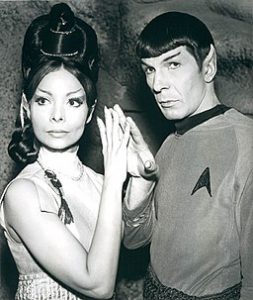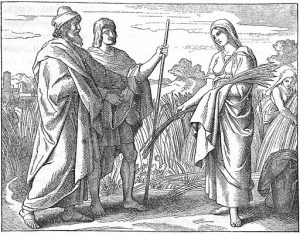by Lois Tverberg
Back when I was in school, my friends and I were huge fans of Star Trek:  The Next Generation. Every Monday morning, all we talked about was the previous evening’s new episode. At first we just focused on the science fiction, discussing how Jean-Luke Picard dealt with whatever strange planetary life form that he had encountered that week.
The Next Generation. Every Monday morning, all we talked about was the previous evening’s new episode. At first we just focused on the science fiction, discussing how Jean-Luke Picard dealt with whatever strange planetary life form that he had encountered that week.
After a while, though, we became engrossed in the plots that were interwoven into many episodes and would surface again in later programs. Data, the android, would discover one week that his creator had also fashioned an evil twin “brother” named Lore, and weeks later, their relationship would come up in the characters’ conversation. Months later Lore would return, now possessing the “emotion-chip” that Data had dearly desired since he was first built.
Over time we saw that key to enjoying the show was paying attention to the crew’s offhand remarks about the past, and then thinking back to how earlier episodes shed light on the current story. Like any well-written series, each program would tell a good story, but a long-time follower would be able to see how the intrigue grew as the plot thickened over time.
As I learned to read the Bible in its ancient Eastern setting, I discovered that it’s actually a lot like this. Why? Because memory and history were central to the fabric of ancient Eastern culture. The ancients were very aware of ancestral relationships and oral history handed down to them, and used it to understand later events. Especially important to them was the first place they found something, because it usually set up relationships and patterns that would come up again and again.
Being aware of this has greatly enriched my Bible study, because the Scriptures are written with this in mind. As a child, my Bible story book trained me to read the Scripture as a series of short stories, mostly unrelated, each with its own moral lesson.
Only after learning about its Eastern setting did I discover that the Old Testament especially is an epic saga with a delightfully interwoven plot. Sometime the Bible includes stories that hardly seem to be moral examples, and I used to wonder why they were there. But they need to be there to explain the deeper meaning of later events.
Let’s look at how an ancient person would read the book of Ruth. I used to simply see it as a nice story about a widow who found a good husband because she was kind to her mother-in-law. But if we lived in biblical times, we would be curious about Ruth’s ancestors, and our ears would prick up to the fact that Ruth was a Moabite.
Immediately we’d think of the scandalous past of her people, and it would cast her story in a different light. We’d recall that when the weary Israelites were journeying to the Promised Land, the Moabites lured the Israelites into sexual immorality and worshipping idols (Numbers 25:1).
From that time on, the Moabites were associated with sexual immorality, even more disgusting because it was how they worshipped their “gods.” Because of that sin, God declared that Moabites were barred from being a part of the assembly of Israel in Deuteronomy 23:3. Was their sin ever forgivable, we’d wonder?
Then we’d think back to the origins of the Moabites in Genesis 19:30-38. After Sodom and Gomorrah were destroyed, we read the not-so-nice story of when Lot’s daughters got their father drunk so that they could become pregnant by him, since their husbands had refused to leave the city and died. One of Lot’s daughters gave birth to a son named Moab, and he became the father of the Moabite people. So that’s why the Moabites are so immoral! This would make complete sense to us, because we’d expect that people would be defined by their ancestry.
Keeping these ideas in mind, now let’s turn to Ruth. She was a Moabite woman who had returned to Israel with her mother-in-law after her husband died. An ancient listener would immediately wonder, was she as immoral as those who came before her? She said that she would worship the God of Israel, but would God ever accept her? We even find her in the same situation as Lot’s daughters! Like them, she was a widow who desperately needed children. Naomi even told her to approach Boaz when he was sleeping outside by his harvest, after he had eaten (and drunk) his fill.
 Unlike her ancestors, however, Boaz proclaimed that she was a virtuous woman (Ruth 3:10). He then married her, and her son became the grandfather of King David. Not only that, but Ruth even appears in Matthew 1:5 as part of the line of Christ! She turned from her people’s unseemly past to embrace the God of Israel. Not only did he accept her and cleanse her from her history, but he gave her a key role in his supreme act of salvation! Those of us who struggle with an embarrassing family history or an immoral past should rejoice to see how God redeemed Ruth and used her for his wonderful purposes.
Unlike her ancestors, however, Boaz proclaimed that she was a virtuous woman (Ruth 3:10). He then married her, and her son became the grandfather of King David. Not only that, but Ruth even appears in Matthew 1:5 as part of the line of Christ! She turned from her people’s unseemly past to embrace the God of Israel. Not only did he accept her and cleanse her from her history, but he gave her a key role in his supreme act of salvation! Those of us who struggle with an embarrassing family history or an immoral past should rejoice to see how God redeemed Ruth and used her for his wonderful purposes.
Understanding how texts interrelate has given me a whole new perspective on reading the Bible. When I used to read the stories by themselves, some of them frustrated me because they didn’t show me how to live. But the difficult ones have a far deeper purpose. They illustrate how the terrible sinfulness of man runs throughout history, but then how God graciously intervened to bring Christ into the world. We need to read with the eyes of an ancient person in order to see how that message is woven into the fabric of the Bible from beginning to end.
~~~~
Photos: NBC Television [Public domain]; The story of the Bible from Genesis to Revelation [Public domain]

